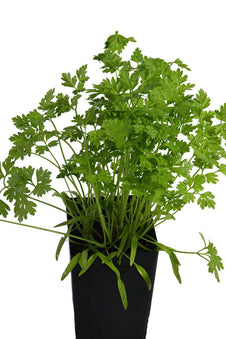
Chervil
Chervil

- In stock, ready to ship
- Inventory on the way

Usually available: April to November
Life cycle: Annual
Height: 40 - 70cm
Position: Part shade
Soil preference: Well drained
This is how we pack and send your Herb Plants to all states except TAS & WA
You will receive
- 1 Chervil Herb Plant in a 50 X 75mm tube - General growing instructions
All of our Herb Plants are grown organically with certified organic potting mixes and fertilizers
Botanical Name: Anthriscus cerefolium
Chervil is an annual that grows well during the winter months here in S.E.Queensland. The plants grow to 40-70cm, with tripinnate leaves. The small white flowers form small umbels, 2.5-5cm across. The fruit is about 1cm long, oblong-ovoid with a slender, ridged beak. As the plant matures, the leaves tend to turn a purple, bronze colour.
Chervil looks like carrot tops it is lacy and delicate with a slight parsley taste and subtle anise flavour.
Use the nutritious leaves to flavour cheese, egg and fish dishes. The leaves can be sprinkled through a salad or added to a white sauce. Mix chopped leaves with a little butter to top vegetables, particularly carrots and potatoes. A staple of classic French cooking It is one of the herbs in the classic French mix - fines herbes – includes equal parts of Parsley, chervil, chives and tarragon. When a recipe calls for ‘Pluches de cerfeuille’, it is leaves of Chervil that are required. Chervil is what gives Béarnaise its distinctive taste. Much of the delicate flavour of Chervil is lost when cooked or heated to a high temperature, so it is best to add chopped Chervil at the end of cooking time or when serving the meal, like in our Healthy Cream of Chervil Soup.
Some quick ways to use Chervil.
- Mix a handful of chopped chervil with sour cream or crème fraiche, season and serve with baked potatoes.
- Mash some chopped chervil into softened butter to serve on seafood, mushrooms or steak. Stir through vegetables such as carrots, peas, corn or baby potatoes.
- Replace basil with chervil in a pesto recipe, and use to spread on biscuits or stir through pasta.
- Mix with whole egg mayo and some Dijon mustard and spread over thinly sliced chicken before grilling.
- Mash some boiled eggs and stir through chopped chervil.
- Roughly chop or tear handfuls of chervil into salads.
How to Grow
Chervil prefers a cool, moist and semi-shaded location. If transplanting take care not to disturb the roots. Chervil grows well in pots. It likes a soil with a pH of 6.0 to 7.0 Propagation is by seed and it is best direct sown in its final growing position. Sow seed from autumn through to winter – lightly cover with soil and kept moist.
All information provided on this website is for informational purposes only. Please seek professional advice before commencing any treatment.




